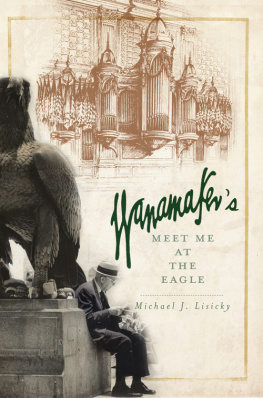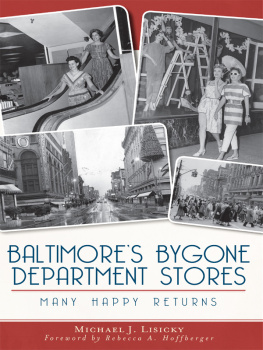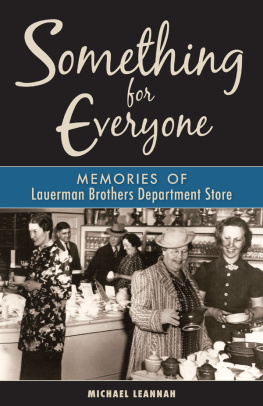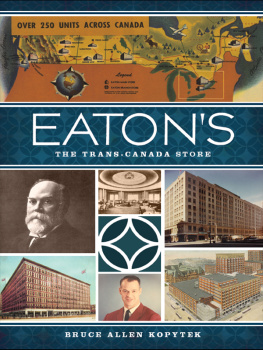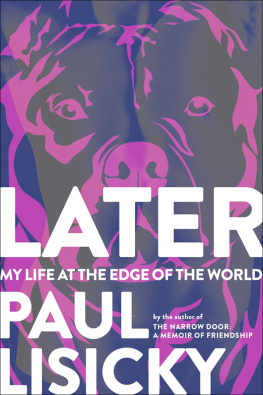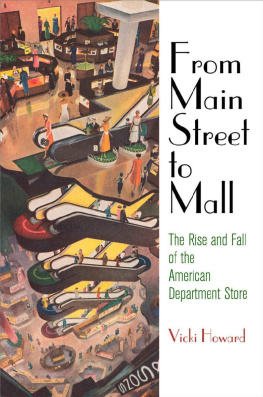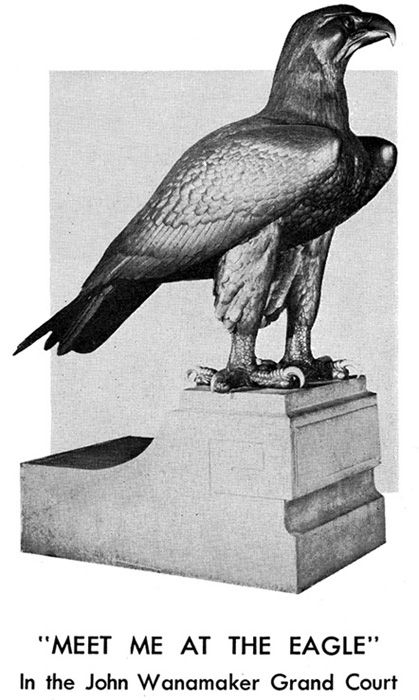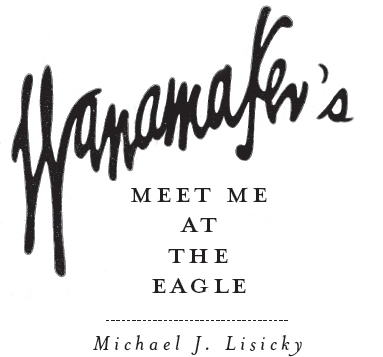From the 1947 brochure Welcome to Philadelphia and John Wanamaker. Courtesy of the author.
Published by The History Press
Charleston, SC 29403
www.historypress.net
Copyright 2010 by Michael J. Lisicky
All rights reserved
First published 2010
e-book edition 2011
ISBN 978.1.61423.030.4
Library of Congress Cataloging-in-Publication Data
Lisicky, Michael J.
Wanamakers : meet me at the eagle / Michael J. Lisicky.
p. cm.
Includes bibliographical references.
print edition: ISBN 978-1-59629-008-2
1. John Wanamaker (Firm)--History. 2. Department storesPennsylvaniaPhiladelphia
History. I. Title.
HF5465.U64J645 2010
381.1410974811--dc22
2010039223
Notice: The information in this book is true and complete to the best of our knowledge. It is offered without guarantee on the part of the author or The History Press. The author and The History Press disclaim all liability in connection with the use of this book.
All rights reserved. No part of this book may be reproduced or transmitted in any form whatsoever without prior written permission from the publisher except in the case of brief quotations embodied in critical articles and reviews.
To my father, Anton, who allowed me to be my own person.
C ONTENTS
F OREWORD
By Dinty W. Moore
T he classic gargantuan department store is as much about fantasy as it is about commerce, though the former has always diligently served the latter. We, the unsophisticated American consumers of the early to mid-twentieth century, still reeling from the advent of electricity and horseless carriages, upon finding ourselves ushered into a veritable Versailles of light, color, sound and aroma (candy counters, hot cashew nuts, perfume, talc, piles of clean, folded cotton linens), are hard-pressed to leave without gathering at least some small bit of this daydream into our glossy shopping bag. We have seen the future of American consumption, and we want some.
The stringed sacks, with elegant logo, are part of the fantasy. Even if we could only afford one pair of socks, a greeting card or a three-pack of handkerchiefs, we have the bag on our arm as we head for the trolley, signaling to our fellow citizens: we shopped well!
Wanamakers is the store of my dreams. Literally.
I remember as a boy falling asleep to a particular and detailed reverie: every other single soul on the planet had somehow disappeared into the vapor and only I had survived. (Yes, I was a lonely kid, with lonely fantasies.) Where would I go? What would I do? How would I, only eight years oldwith no domestic skills, no knowledge of the worldmanage to survive on my own?
The department store, of course.
There was an entire floor devoted to furniture, individual rooms, side by side, ready for occupancy. And all manner of beds, already made. If I tired of one bed, tore the sheets or spilled chocolate milk on my blanket, I could just move on to the next bedfor years.
There was food enough, even without going up to the ninth floors Crystal Tea Room. A boy could live pretty well on pretzels and chocolate creams, couldnt he?
Had I been a little older when this melodramatic fantasy played out in my brain, I would have willed a young woman to survive alongside of me, pig-tailed with a plaid skirt, and eventually (once I conquered my acute embarrassment), we would have started a new race of men. The Department Store People.
The Department Store People would wear fresh clothes each and every day.
We would create a model railroad (linking together every last piece of track found in the toy department) to run the entirety of the store, even up and down the escalators. The Department Store People Railroad would deliver candy, pretzels, soda pop and Mad magazines to the far-flung ends of the store, where various versions of us would be busy making gigantic Erector set treehouses, or playing serial games of Go to the Head of the Class (because our children would need school of some sort) or watching fourteen televisions at once.
We would probably have to clear away at least one end of one floorcertainly we could do without ladies unmentionablesto create space for our weekly DSP League baseball and football games. Given all of the sporting goods equipment available to us, it would be a shame not to play.
I suppose, eventually, our children would want children of their own, so the next generation of Department Store People, once the numbers grew too large, would have to move out and occupy other stores.
Perhaps they would ride bikes to New York City, and occupy Macys.
But thats getting too far ahead. In the near term, my new race of men could survive anything, even nuclear winter, inside of Wanamakers. The sheer bulk of it: one entire downtown Philadelphia city block, across from City Hall, twelve floors above ground and two more below, nearly two million square feet. So big it needed its own post office and radio station. The walls made of granite.
John Wanamaker wanted to make a statement, apparently. And he did.
Barred from enlistment during the Civil War because of a nagging cough, he threw his considerable energy into the art of selling and managed to alter the customerstorekeeper relationship forever. Wanamaker pioneered truth in advertising (though he wouldnt advertise on Sundays, the day of rest). He was first with a return it for your money back if not satisfied policy. He brought us White Sales and a firm price tag, with no haggling. His first Philadelphia store introduced electrical illumination, telephones and pneumatic tubes to the retail world.
But it is not John Wanamakers first store that I remember so wellit is his masterpiece, that mammoth granite block of Brotherly Love and Commerce, the Florentine flagship at Thirteenth and Market, dedicated by President William Howard Taft on December 30, 1911.
I worked at the downtown store, for two days.
Day one was training, and I was thrilled to discover an entire second world hidden behind the false showroom walls. The Wanamakers that shoppers knew, it turned out, was merely a colossal box inside of an even more colossal box. Along all four outer walls, ringing all nine retail floors, was another layer, an exoskeleton of hidden stairwells, offices, storerooms, break roomsdusty and colorlessin perfect contrast to the public spectacle. A city within a city within the city of Philadelphia.
My second day, I folded sweaters.
My third day, I found a better job.
But I never fell out of love for the place. I never stopped yearning to say to my friends, meet me by the Eagle, meaning (as everyone knew) the 2,500-pound bronze bird in the marble-clad atrium.
Joan Didion once wrote, Of course great hotels have always been social ideas, flawless mirrors to the particular societies they service.
So true. And true as well of the classic department store.
Wanamakers embodied the aspirations of countless Philadelphians, just as Macys did for millions in New York City, and for the endless crowds of tourists who stepped off the bus and headed straight for Herald Square. Chicago had Marshall Fields, San Francisco had the Emporium and London had Harrods.

